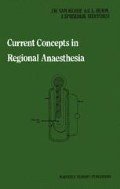Abstract
As a technique, continuous epidural analgesia has been available since the introduction of catheters small enough to pass through introducing needles. The most commonly employed for this purpose was originally designed by Tuohy to facilitate the passage of a catheter into the subarachnoid space for continuous spinal block.1
Access this chapter
Tax calculation will be finalised at checkout
Purchases are for personal use only
Preview
Unable to display preview. Download preview PDF.
References
Tuohy, E.B. Continuous Spinal Anesthesia: Its usefulness and technic involved. Anesthesiology 5:142, 1944.
Griffiths, D.P.G., Diamond, A.W. and Cameron, J.D. Postoperative extradural analgesia following thoracic surgery. A feasibility study. Br. J. Anaesth. 47:40, 1975.
Spoerel, W.E., Thomas, A., and Gerula, G.R. Continuous epidural analgesia: Experience with mechanical injection devices. Can. Anaes. Soc. J. 17:37, 1970.
Green, R., and Dawkins, C.J.M. Postoperative analgesia: The use of continuous drip epidural block. Anaesthesia 21:372, 1966.
Tucker, G.T., et al: Observed and predicted accumulation of local anaesthetic agents during continuous extradural analgesia. Br. J. Anaesth. 49:237, 1977.
Bromage, P.R., Spirometry in assessment of analgesia after upper abdominal surgery: A method of comparing analgesic drugs. Br. Med. J., 2:589, 1955.
Lahnborg, G. and Bergstrom, K. Clinical and haemostatic parameters related to thromboembolism and low-dose heparin prophylaxis in major surgery. Acta Clin. Scand. 141:590, 1975.
Modig, J., Borg, T., Karlstrom, G., Maripui, E., Sahlstedt, B. Thromboembolism after hip replacement: role of epidural and of general anaesthesia. Anesth. Analg. 1982 (In press).
Sandman, W., Kremer, K., Wüst, H., Florack, G., Ruf, S. Funktionskontrone von rekonstruierten arterien durch postoperative elektromagnetische Strömungsmessung. Thoraxchirurgie 25:427, 1977.
Sandman, W., Wüst, H., Lerut, J. Der einfluss der periduralanaesthesie auf das strömungsverhalten in der vena femoraus. Neueaspekte in der regionalanaesthesie 2. Anaesthesiologie u intensivmedizin 138:128, 1981.
Engquist, A., Brandt, M.R., Fernandes, A., Kehlet, H. The blocking effect of epidural analgesia on the adrenocortical and hyperglycenic responses to surgery. Acta Anaesthesiol. Scand. 21:330, 1977.
Engquist, A., Fog-Møller, F., Christiansen, C., Thode, J., Vester-Anderson, T., Nistrup Madsen, S. Influence of epidural analgesia on the catecholamine and cyclic AMP responses to surgery. Acta Anaesthesia Scand. 24:17, 1980.
Kehlet, H. The modifying effect of general and regional anesthesia on the endocrine-metabolic response to surgery. Regional Anesthesia. Supp. Vol. 74:38, 1982.
Brandt, M.R., Ølgaard, K., Kehlet, H. Epidural analgesia inhibits the renin and aldosterone response to surgery. Acta Anaesthesiol. Scand. 23:267, 1979.
Pflug, A.E., Murphy, T.M., Butler, S.H. and Tucker, G.T. The effects of postoperative peridural analgesia on pulmonary therapy and pulmonary complications. Anesthesiology 41:8, 1974.
Bromage, P.R., Pettigrew, R.T. and Crowell, D.E. Tachyphylaxis in epidural analgesia 1. Augmentation and decay of local analgesia. J. Clin. Pharmacol. 9:30, 1969.
Editor information
Editors and Affiliations
Rights and permissions
Copyright information
© 1984 Martinus Nijhoff Publishers, The Hague
About this chapter
Cite this chapter
Stanton-Hicks, M.D. (1984). Continuous Epidural Anaesthesia Advantages and Disadvantages. In: Van Kleef, J.W., Burm, A.G.L., Spierdijk, J. (eds) Current Concepts in Regional Anaesthesia. Developments in Critical Care Medicine and Anaesthesiology, vol 7. Springer, Dordrecht. https://doi.org/10.1007/978-94-009-6015-2_25
Download citation
DOI: https://doi.org/10.1007/978-94-009-6015-2_25
Publisher Name: Springer, Dordrecht
Print ISBN: 978-94-009-6017-6
Online ISBN: 978-94-009-6015-2
eBook Packages: Springer Book Archive

